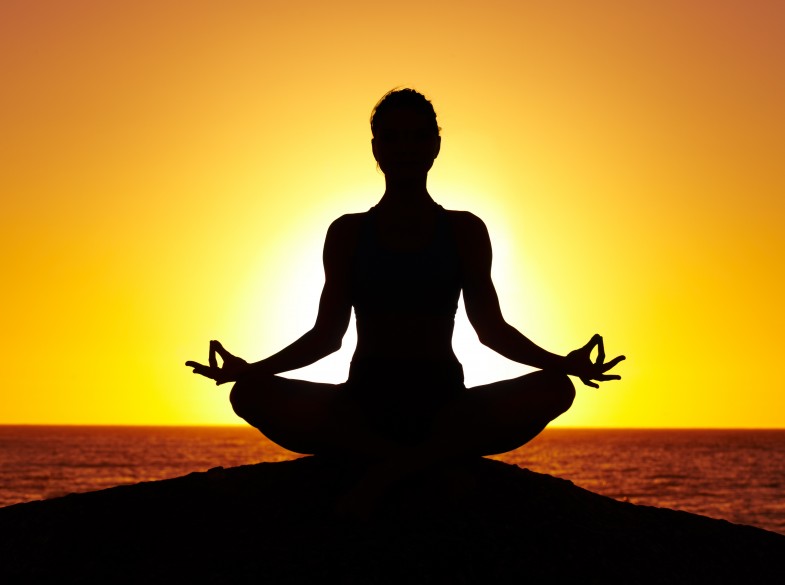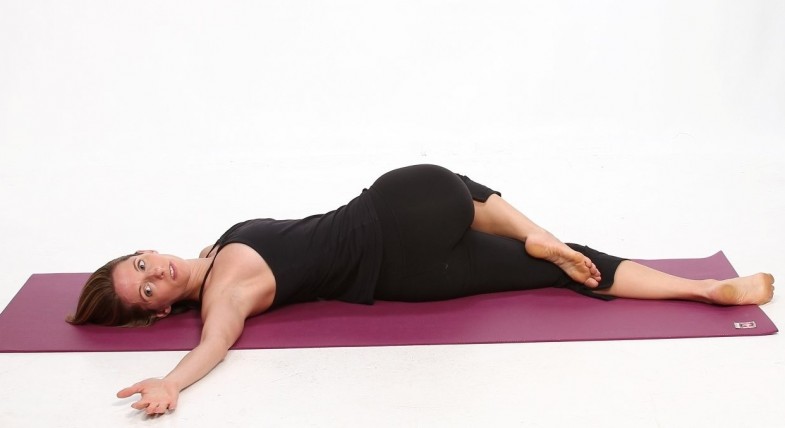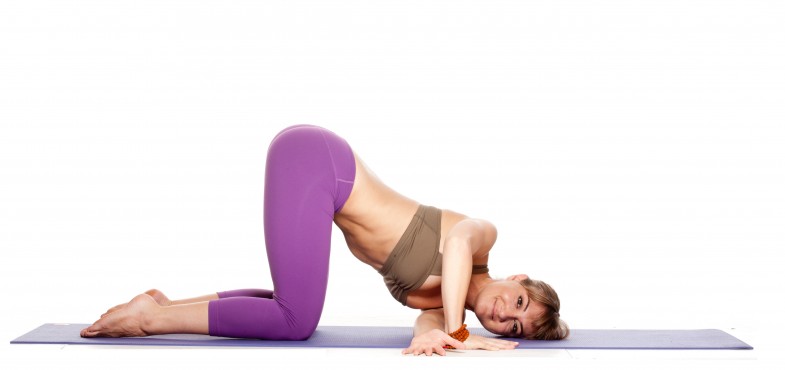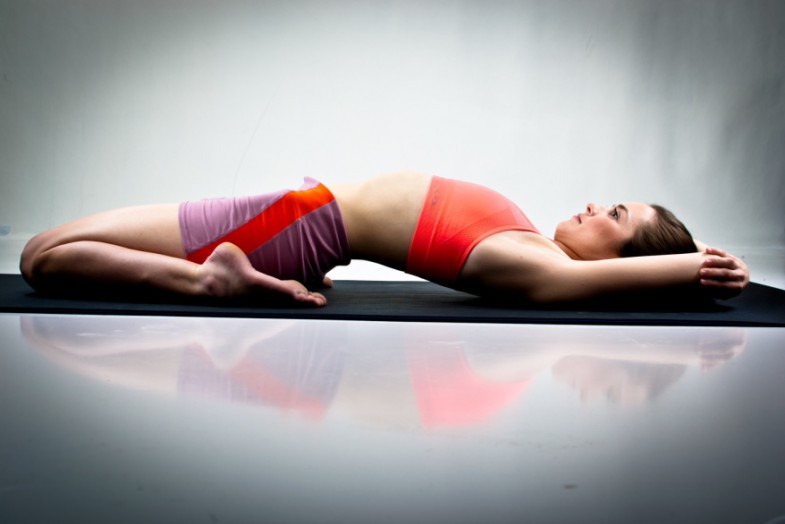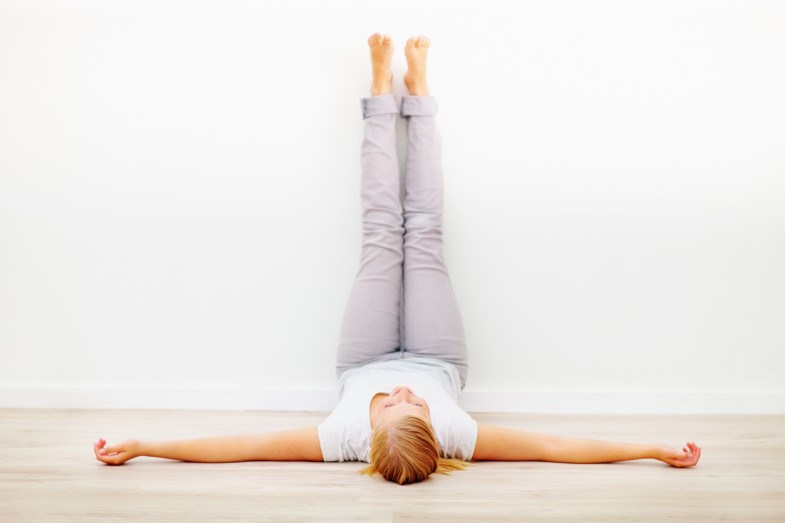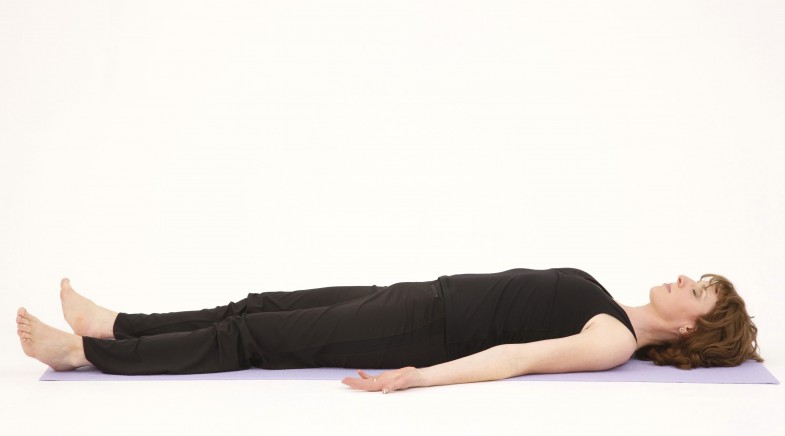Start tomorrow today
An evening routine is a great way to set yourself up to experience an awesome tomorrow. A relaxing bath, a yummy glass of warm, spiced milk or maybe even some journaling are a few actions that could make the morning great. Another great choice is yoga, right there in your bed.
Asanas to do before going to Sleep:
Here are a few asanas that you can do before going to sleep that may help you rest better.
1. Jathara Parivartanasana
Jathara means stomach; Parivartanasana means turning or rolling about. If you come to my classes, it is no surprise that I love this pose. Of all the poses, I think this pose and its variations are responsible for keeping me flexible. I always practice this pose before going to sleep and have for the past 20 something years. Ease into it if it is your first time exploring this pose.
Steps:
1. Lie on your back with your legs extended.
2. Draw your knees up into your chest one at a time and wrap your arms around your legs, hugging them. Rock side to side to massage the back.
3. Continue holding onto your right knee with both hands and extend your left leg all the way out onto the bed.
4. With your left hand on the right knee, draw the right knee across the left side of the body towards the bed. Keep both shoulders down and extend the left arm straight away from the body.
5. Hold for a few breaths or until the back releases, (or relax and enjoy for a few minutes). Inhale, bring both knees and head back to center, and repeat on the other side.
Modifications and Props:
• Use a blanket under the knee if you feel you need some support (so your knee isn’t just hanging there).
Variations:
• Take both knees to the left and hold the right knee down with the left hand. Release your back. Hold for a few breaths and come back to center. Repeat on the other side.
Benefits:
• Stretches the spine and shoulders
• Improves digestion and circulation
• Strengthens the lower back
• Relieves lower backache, neck pain, and sciatica
• Opens the hips and chest
Contraindications: (or reasons not to do this pose)
• High or low blood pressure
• Diarrhea
• Headache
• Menstruation
• High blood pressure
2. Thread the Needle Pose
I have really tight shoulders from biking, especially the rhomboids (muscles between the shoulder blades). This pose helps to stretch them so that prāna can have a head start in healing this tricky part of the back.
Steps:
1. Start in table position.
2. Weave the left arm under the right and place straight away from the body, as you twist through the lumbar and thoracic spine, place the shoulder on the floor.
3. Lift right arm up towards the ceiling and intensify the stretch.
4. Keep the majority of the weight on the shoulder to create the traction for the stretch.
5. Repeat other side.
Modifications and props:
• Place a blanket on the bed and place the shoulder on it if padding is needed.
• Can be made into a balance by lifting the leg on the same side as the arm that is lifted.
Benefits:
• Stretches shoulders and posterior rotator cuffs
• Stretches oblique
• Strengthens legs
Contraindications:
• Neck injuries
• Upper back injuries
• Migraines
• Pregnancy
3. Supta Virasana
Supta means lying down, vira means hero. I always say that “no pain, no gain” is such a washed up theory. You shouldn’t have to experience pain in order to manifest what you need. That is silly. This pose, however, shoots holes in my theory if the legs and back are not ready for it. So one of the best places to try it out is on your bed, where the mattress can give space when the muscles and tendons do not. Use blankets and pillows for comfort.
Steps:
1. Start in Virasana (Hero’s pose).
2. Exhale and lean back onto your hands, then your forearms and elbows.
3. Once you are on your elbows, place your hands on the back of the pelvis and release your lower back and upper buttocks by spreading the flesh down toward the tailbone.
4. Then finish reclining, either onto the bed or the support of blankets or bolsters. Take both arms out to the side.
5. Stay in this pose for 30 seconds to 1 minute. Gradually extend your stay to 5 minutes. To come out of the pose, inhale and press your forearms against the bed, exhale and bring your chin towards your chest and come onto your hands back into Virasana. As you come up, lead with your sternum, not your head or chin.
Modifications and Propping:
• If you’re not able to recline fully on the bed, set a bolster or one or more folded blankets behind yourself to fully support your spine and head.
• Use as much height as you need to make the position reasonably comfortable.
• To help release the groins, lay some weight across the creases of the top thighs where they join the front pelvis.
• Start with a 10-pound sandbag and gradually over time increase the weight to 30 pounds or so.
Variations:
• Before doing Supta Virasana you can start with its halfway variation, Supta Ardha Virasana (Ardhameans half). To sit in Ardha Virasana, draw just your right leg back into Virasana. You can keep your left knee bent with the foot on the floor, or straighten your left leg by pushing out through the heel. Then recline as described above, either onto a support or the bed. Come out as recommended for Supta Virasana, then repeat with the left leg back.
Benefits:
• Stretches the abdomen, thighs, and deep hip flexors (psoas), knees, and ankles
• Strengthens the arches
• Relieves tired legs
• Improves digestion
• Helps relieve the symptoms of menstrual pain
Contraindications:
• Serious back problems
• Knee issues
• Ankle problems
• Avoid this pose unless you have the assistance of an experienced instructor.
4. Viparita Karani
Viparita means turned around, reversed, inverted; karani means doing, making, action. This is every body’s favorite pose. It is not only good for relaxation, but I could write an entire blog on the benefits this pose has when it comes to your lymphatic (immune) system. Proper propping is a must here. Go for the joy, bliss and just ahhh factor.
Steps:
1. Take two folded blankets placing the raw edges against a wall. Sit with your right side against the wall or headboard and your back against the blankets. Exhale, and with one smooth movement, and swing your legs up onto the wall or headboard as your bottom comes up onto the blankets and your shoulders and head slide down onto the bed.
2. Your sitting bones don’t need to be right against the wall, but they can be “dipping” down into the space between the support and the wall or headboard.
3. Lift and release the base of your skull away from the back of your neck and soften your throat. Open your shoulder blades away from the spine and release your hands and arms out to your sides, palms up.
4. Keep your legs relatively firm, just enough to hold them vertically in place. Release the heads of the thigh bones and the weight of your belly deeply into your torso, toward the back of the pelvis. Soften your eyes and turn them down to look into your heart.
5. Stay in this pose anywhere from 5 to 15 minutes. To come out of the pose, slide the legs down the wall (headboard), bend the knees and slowly sit up.
Variations:
• If you have enough wall space, you can slide your legs apart into a wide “V” to stretch your inner thighs and groins.
• You also can bend your knees, touch the soles of your feet together, and slide the outer edges of your feet down the wall, bringing your heels toward the pelvis.
• Then you can push your hands against the top inner thighs to stretch the groins.
• Remember, however, never push on your knees to open the groins.
Benefits:
• Anxiety
• Arthritis
• Digestive problems
• Headache
• High and low blood pressure
• Insomnia
• Migraine
• Mild depression
• Respiratory ailments
• Urinary disorders
• Varicose veins
• Menstrual cramps (performing pose during menstruation)
• Premenstrual syndrome
• Menopause
• Relieves tired or cramped legs and feet
• Gently stretches the back legs, front torso, and the back of the neck
• Relieves mild backache
• Calms the mind
• Helps drain lymphatic system
Contraindications
• During menstruation
• Serious eye problems
• Glaucoma
• Serious neck problems
• Serious back problems
5. Savasana
Sava means corpse (Corpse Pose). This is a great way to balance your prāna before you move to your favorite sleep position.
Steps:
1. From a seated position, roll down one vertebrae at a time, flex the knees as you roll down. Once your back is on the bed, straighten the legs. Allow the legs to open naturally. Lightly lift your buttocks off the bed by pushing down with your hands and lengthen through the lumbar spine. Lower the buttocks back to the bed.
2. Dorsi flex the right foot and lengthen the leg. Plantar flex the foot and hold for a couple of seconds. Then relax muscles in the leg, the ankle, and toes. Do the same for the left leg. Allow the calf and inner thigh to release. Leg may turn outwards naturally.
3. Lengthen the arms above your head for a long stretch, and then take them towards the ceiling as you open up your back, allowing the shoulder blades to stretch away from the spine. Bring the hands down by your sides with the palms facing the ceiling. Spread the fingers and then relax the shoulders and hands.
4. Bringing the chin to the chest, stretch the neck. Then lay the head back to the bed. Relax the jaw and soften the tongue off the top of the mouth.
5. Taking long deep breaths, allow the body to release any tension that remains in the body.
6. Stay in Savasana for 5-15 minutes. When you are ready to come out of the pose, take a couple of deep breaths, wiggle toes and fingers, and when ready, roll to the right side for a couple of breaths. By pressing the left hand into the bed, slowly push yourself up to seated position.
Modifications and propping:
• You can use a folded blanket or towel under the neck for comfort. You can also use an eye cover to help with relaxation.
• If it hurts your lower back to keep legs straight, you can place a folded blanket or bolster under the knees.
• If it hurts legs to allow them to turn outward, you can use a strap around the feet to keep the hips turned forward.
I think you will enjoy your “before you go to bed” poses so much that upon waking, you will want to do a few more asana to transition into the day centered and balanced. Watch for my next article on Yoga Asanas to do in Bed when you Wake up.
Source: curejoy.com
